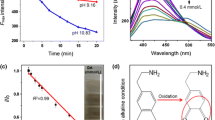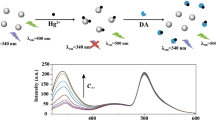Abstract
Propafenone hydrochloride (PPF) is an antiarrhythmic drug used for the treatment of heart diseases with complex pharmacokinetics and a strict requirement on dosage. Current analytical methods for PPF determination require expensive instruments or much time for sample pre-treatment. Thus, it is urgent to establish a simple and time-saving approach for PPF determination. In this work, the dual emissive carbon dots (DECDs) were synthesized through one-step solvothermal treatment with m-aminophenol and citric acid. Two separate fluorescence emission peaks at 340 nm and 420 nm of DECDs are observed under the excitation wavelength of 306 nm. In the presence of PPF, the fluorescence signal at 340 nm decreased, while the signal at 420 nm gradually increased. We interestingly found that the fluorescence signal ratio (F420/F340) linearly changed with the concentration of PPF. Therefore, a simple and time-saving ratiometric fluorescent approach for the determination of PPF was developed using DECDs as a probe, showing an excellent linear range from 900 to 100 μM. The detection limit is calculated to be 88 nM. It is a simple and low-cost strategy for PPF detection. The content of PPF was successfully analyzed in commercial tablets and in complex biological samples with satisfactory recoveries (ranging from 97.1 to 103.3%), showing great potential for application in clinical research.






Similar content being viewed by others
References
Abdel Hamid MA, Mabrouk MM, Ahmed HM, Samy B, Batakoushy HAJL (2022) Carbon quantum dots as a sensitive fluorescent probe for quantitation of pregabalin; application to real samples and content uniformity test. Lumunescence 37:170–176. https://doi.org/10.1002/bio.4158
Afshar M, Rouini M (2004) A rapid HPLC assay for the simultaneous determination of propafenone and its major metabolites in human serum. Anal Sci 20:1307–1311. https://doi.org/10.2116/analsci.20.1307
Afshar M, Thorman W (2006) Validated capillary electrophoresis assay for the simultaneous enantioselective determination of propafenone and its major metabolites in biological samples. Electrophoresis 27:1517–1525. https://doi.org/10.1002/elps.200500663
Alaghmandfard A, Sedighi O, TabatabaeiRezaei N, Abedini AA, MalekKhachatourian A, Toprak MS, Seifalian A (2021) Recent advances in the modification of carbon-based quantum dots for biomedical applications. Mater Sci Eng C 120:111756. https://doi.org/10.1016/j.msec.2020.111756
Andy A, Kallem RR, Mullangi R, Andy D, Seshagiri J (2017) Highly sensitive UHPLC-MS/MS method for the simultaneous estimation of propafenone and its metabolites 5-hydroxypropafenone and N-depropylpropafenone on human dried blood spots technique and application to a pharmacokinetic study. J Pharm Biomed Anal 142:328–336. https://doi.org/10.1016/j.jpba.2017.04.046
Bhattacharya S, Sarkar R, Chakraborty B, Porgador A, Jelinek R (2017) Nitric oxide sensing through azo-dye formation on carbon dots. ACS Sens 2:1215–1224. https://doi.org/10.1021/acssensors.7b00356
Bryson HM, Palmer KJ, Langtry HD, Fitton A (1993) Propafenone. A reappraisal of its pharmacology, pharmacokinetics and therapeutic use in cardiac arrhythmias. Drugs 45:85–130. https://doi.org/10.2165/00003495-199345010-00008
Capucci A, Boriani G (1995) Propafenone in the treatment of cardiac arrhythmias. A risk-benefit appraisal. Drug Saf 12:55–72. https://doi.org/10.2165/00002018-199512010-00005
Chu H, Yao D, Chen J, Yu M, Su L (2021) Detection of Hg(2+) by a dual-fluorescence ratio probe constructed with rare-earth-element-doped cadmium telluride quantum dots and fluorescent carbon dots. ACS Omega 6:10735–10744. https://doi.org/10.1021/acsomega.1c00263
Farag AS, Bakirhan NK, Svancara I, Ozkan SA (2019) A new sensing platform based on NH2fMWCNTs for the determination of antiarrhythmic drug Propafenone in pharmaceutical dosage forms. J Pharm Biomed Anal 174:534–540. https://doi.org/10.1016/j.jpba.2019.06.026
Funck-Brentano C, Kroemer HK, Lee JT, Roden DM (1990) Propafenone. N Engl J Med 322:518–525. https://doi.org/10.1056/NEJM199002223220806
Hii JT, Duff HJ, Burgess ED (1991) Clinical pharmacokinetics of propafenone. Clin Pharmacokinet 21:1–10. https://doi.org/10.2165/00003088-199121010-00001
Hofmann U, Pecia M, Heinkele G, Dilger K, Kroemer HK, Eichelbaum M (2000) Determination of propafenone and its phase I and phase II metabolites in plasma and urine by high-performance liquid chromatography-electrospray ionization mass spectrometry. J Chromatogr B Biomed Sci Appl 748:113–123. https://doi.org/10.1016/s0378-4347(00)00292-9
Jiang X, Jin H, Sun Y, Gui R (2019) Colorimetric and fluorometric dual-channel ratiometric determination of fungicide cymoxanil based on analyte-induced aggregation of silver nanoparticles and dually emitting carbon dots. Mikrochim Acta 186:580. https://doi.org/10.1007/s00604-019-3697-x
Liu C, Ning D, Zhang C, Liu Z, Zhang R, Zhao J, Zhang Z (2017) Dual-colored carbon dot ratiometric fluorescent test paper based on a specific spectral energy transfer for semiquantitative assay of copper ions. ACS Appl Mater Interfaces 9:18897–18903. https://doi.org/10.1021/acsami.7b05827
Lu H, Quan S, Xu S (2017) highly sensitive ratiometric fluorescent sensor for trinitrotoluene based on the inner filter effect between gold nanoparticles and fluorescent nanoparticles. J Agric Food Chem 65:9807–9814. https://doi.org/10.1021/acs.jafc.7b03986
Lu Q, Wang J, Li B, Weng C, Li X, Yang W, Zhou X (2020) Dual-emission reverse change ratio photoluminescence sensor based on a probe of nitrogen-doped Ti3C2 quantum Dots@ DAP to detect H2O2 and xanthine. Anal Chem 92:7770–7777. https://doi.org/10.1021/acs.analchem.0c00895
Mahmoud AM, El-Wekil MM, Ali R, Batakoushy HA, Shahin RYJMA (2022) Double-signal quantification of amoxicillin based on interaction with 4-aminoantipyrine at copper and nitrogen co-doped carbon quantum dots as an artificial nanozyme. Microchim Acta 189:1–13. https://doi.org/10.1007/s00604-022-05253-1
Pan M, Xie X, Liu K, Yang J, Hong L, Wang S (2020) Fluorescent carbon quantum dots-synthesis, functionalization and sensing application in foodanalysis. Nanomaterials 10:930. https://doi.org/10.3390/nano10050930
Papadopoulou A, Green RJ, Frazier RA (2005) Interaction of flavonoids with bovine serum albumin: a fluorescence quenching study. J Agric Food Chem 53:158–163. https://doi.org/10.1021/jf048693g
Patel H, Ghoghari A, Bhatt C, Shah S, Jha A, Desai N, Srinivas NR (2017) A sensitive quantitative assay for the determination of propafenone and two metabolites, 5-hydroxypropafenone and N-depropylpropafenone, in human K2EDTA plasma using LC-MS/MS with ESI operated in positive mode. Biomed Chromatogr 31:e3967. https://doi.org/10.1002/bmc.3967
Shangguan J, He D, He X, Wang K, Xu F, Liu J, Huang J (2016) Label-Free carbon-dots-based ratiometric fluorescence pH nanoprobes for intracellular pH sensing. Anal Chem 88:7837–7843. https://doi.org/10.1021/acs.analchem.6b01932
Sharma A, Gadly T, Neogy S, Ghosh SK, Kumbhakar M (2017) Molecular origin and self-assembly of fluorescent carbon nanodots in polar solvents. J Phys Chem Lett 8:1044–1052. https://doi.org/10.1021/acs.jpclett.7b00170
Shirayama Y, Doki K, Sekiguchi Y, Aonuma K, Kohda Y, Homma M (2018) Simultaneous determination of serum propafenone and its metabolites using high-performance liquid chromatography. Biomed Chromatogr 32:e4099. https://doi.org/10.1002/bmc.4099
Singh I, Arora R, Dhiman H, Pahwa R (2018) Carbon quantum dots: synthesis, characterization and biomedical applications. Turk J Pharm Sci 15:219–230. https://doi.org/10.4274/tjps.63497
Song W, Duan W, Liu Y, Ye Z, Chen Y, Chen H, Chen X (2017) Ratiometric detection of intracellular lysine and ph with one-pot synthesized dual emissive carbon dots. Anal Chem 89:13626–13633. https://doi.org/10.1021/acs.analchem.7b04211
Wang L, Yin Y, Jain A, Zhou HS (2014) Aqueous phase synthesis of highly luminescent, nitrogen-doped carbon dots and their application as bioimaging agents. Langmuir 30:14270–14275. https://doi.org/10.1021/la5031813
Wang X, Liu Z, Gao P, Li Y, Qu X (2020) Surface functionalized quantum dots as biosensor for highly selective and sensitive detection of ppb level of propafenone. Spectrochim Acta A Mol Biomol Spectrosc 227:117709. https://doi.org/10.1016/j.saa.2019.117709
Xu H, Yang X, Li G, Zhao C, Liao X (2015) Green synthesis of fluorescent carbon dots for selective detection of tartrazine in food samples. J Agric Food Chem 63:6707–6714. https://doi.org/10.1021/acs.jafc.5b02319
Yahaya PM, Zainal AZ, Abdul RS, Md YF, Noor ASM, Issa MA (2020) Eco-friendly sustainable fluorescent carbon dots for the adsorption of heavy metal ions in aqueous environment. Nanomaterials 10:315. https://doi.org/10.3390/nano10020315
Yeung A, Shanks D, Parwana H, Gin K (2010) Acute propafenone toxicity after two exposures at standard dosing. Can J Cardiol 26:209–210. https://doi.org/10.1016/s0828-282x(10)70402-5
Yoo D, Park Y, Cheon B, Park MH (2019) Carbon dots as an effective fluorescent sensing platform for metal ion detection. Nanoscale Res Lett 14:272. https://doi.org/10.1186/s11671-019-3088-6
Zhang H, Chen Y, Liang M, Xu L, Qi S, Chen H, Chen X (2014) Solid-phase synthesis of highly fluorescent nitrogen-doped carbon dots for sensitive and selective probing ferric ions in living cells. Anal Chem 86:9846–9852. https://doi.org/10.1021/ac502446m
Zhang Y, Wan J, Wu W, Li C, Ma H (2020) A green, economic “switch-on” sensor for cefixime analysis based on black soya bean carbon quantum dots. J AOAC Int 103:1230–1236. https://doi.org/10.1093/jaoacint/qsaa018
Zheng XT, Ananthanarayanan A, Luo KQ, Chen P (2015) Glowing graphene quantum dots and carbon dots: properties, syntheses, and biological applications. Small 11:1620–1636. https://doi.org/10.1002/smll.201402648
Zhou J, Han T, Ma H, Yan T, Pang X, Li Y, Wei Q (2015) A novel electrochemiluminescent immunosensor based on the quenching effect of aminated graphene on nitrogen-doped carbon quantum dots. Anal Chim Acta 889:82–89. https://doi.org/10.1016/j.aca.2015.07.018
Zhu PP, Cheng Z, Du LL, Chen Q, Tan KJ (2018) Synthesis of the cu-doped dual-emission fluorescent carbon dots and its analytical application. Langmuir 34:9982–9989. https://doi.org/10.1021/acs.langmuir.8b01230
Acknowledgements
This work was supported by PhD start-up fund of Yan’an University (YDBK2020-30, YDBK2022-15); Scientific Research Projects of Education Department of Shaanxi Provincial Government (22JK0614) and Health Research Project of Shaanxi Province (2022E019).
Author information
Authors and Affiliations
Contributions
YZ, LS and HM conceived and designed the study. YZ, JZ and RT carried out the studies and performed experiments; YZ, JZ, and HM analyzed the data; LS provided advice and technical assistance; YZ, JZ, LS and HM wrote the manuscript. All authors read and approved the final manuscript.
Corresponding authors
Ethics declarations
Conflicts of interest
The authors declare that they have no known competing financial interests or personal relationships that could have appeared to influence the work reported in this paper.
Additional information
Publisher's Note
Springer Nature remains neutral with regard to jurisdictional claims in published maps and institutional affiliations.
Supplementary Information
Below is the link to the electronic supplementary material.
Rights and permissions
Springer Nature or its licensor holds exclusive rights to this article under a publishing agreement with the author(s) or other rightsholder(s); author self-archiving of the accepted manuscript version of this article is solely governed by the terms of such publishing agreement and applicable law.
About this article
Cite this article
Zhang, Y., Zhang, J., Sun, L. et al. Ratiometric detection of propafenone hydrochloride with one-pot synthesized dual emissive carbon dots. Chem. Pap. 77, 375–383 (2023). https://doi.org/10.1007/s11696-022-02489-2
Received:
Accepted:
Published:
Issue Date:
DOI: https://doi.org/10.1007/s11696-022-02489-2




